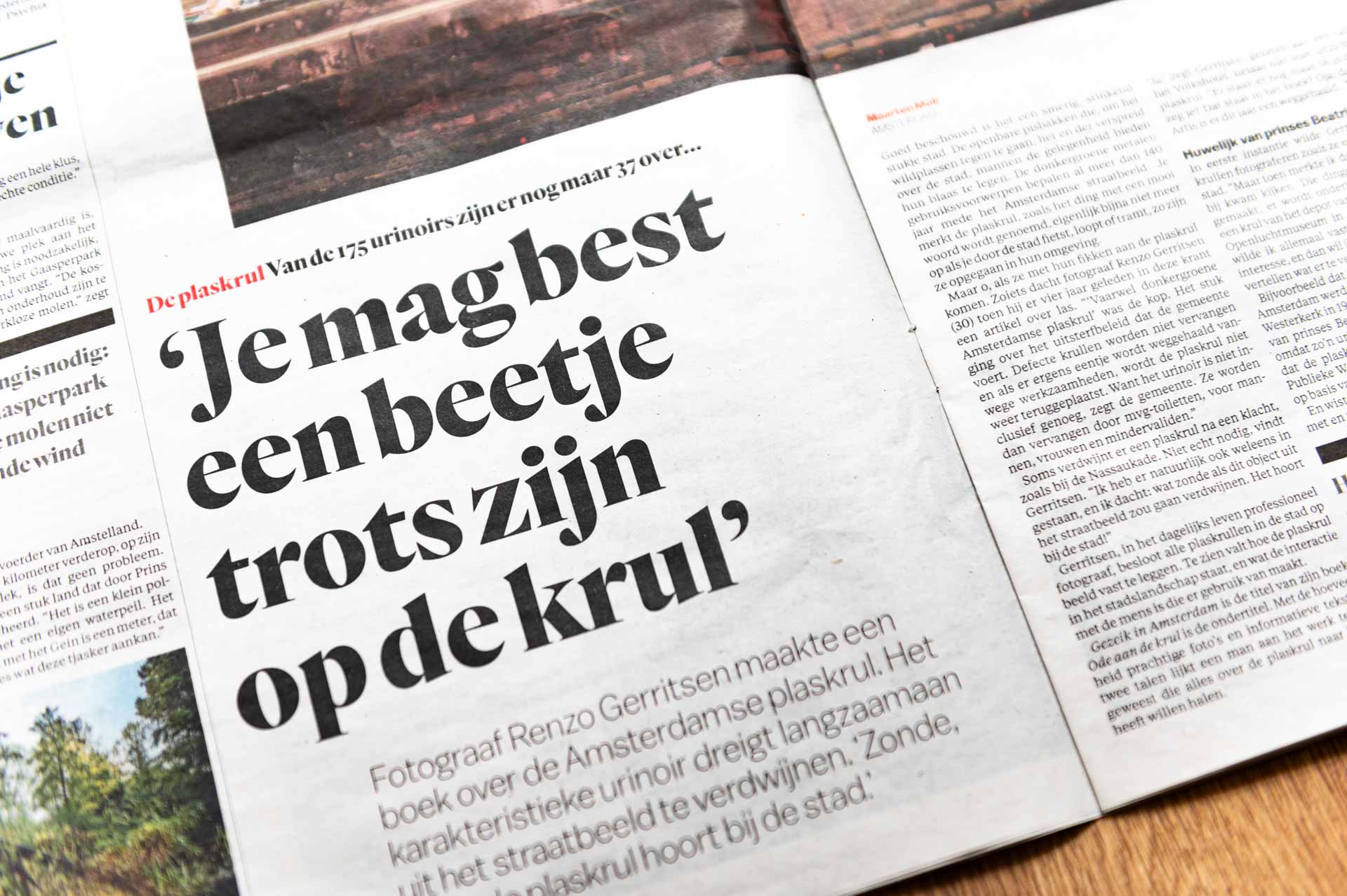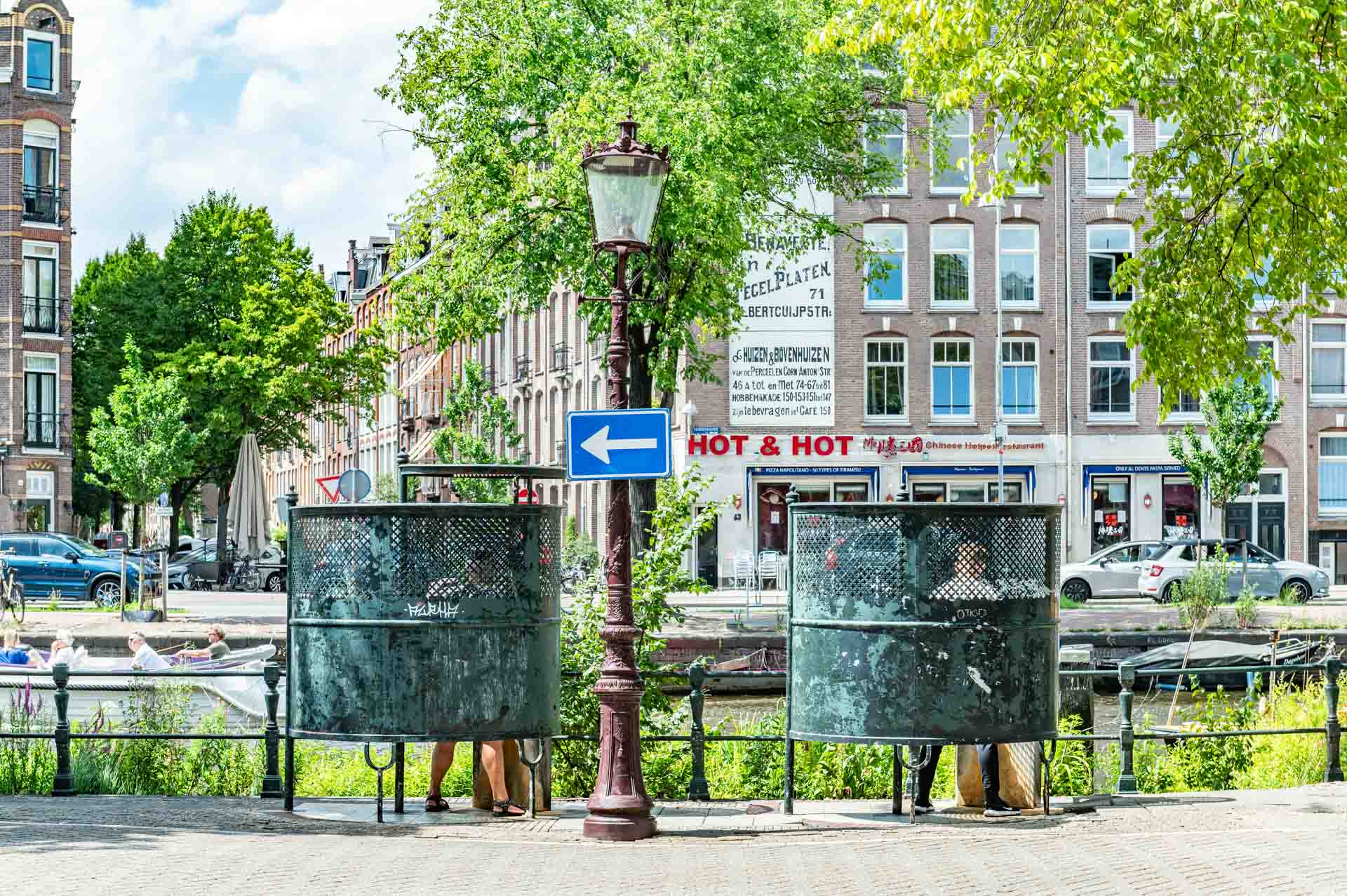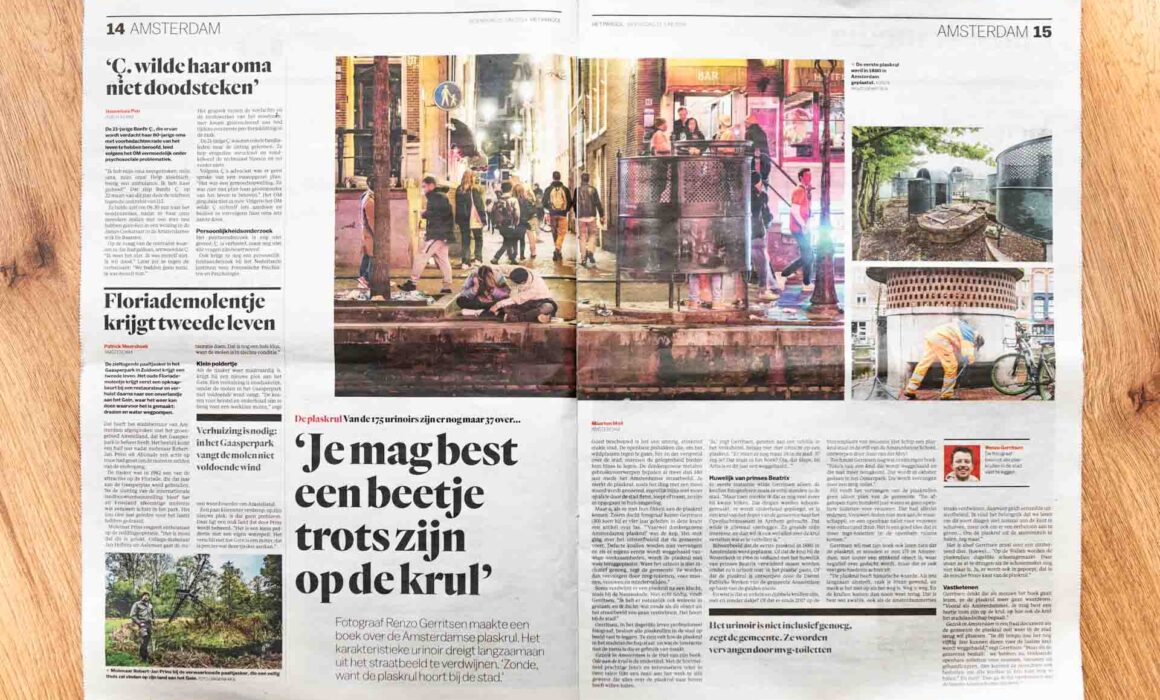Taking a Piss in Amsterdam in Het Parool: “Then I’ll chain myself up”
The Amsterdam pee curl is slowly disappearing from the city streets of Amsterdam. Photographer Renzo Gerritsen thinks that is a shame and has captured all 37 remaining curls on photo and in writing. ‘I want to tell everything there is to tell about the curl.’
Taking a Piss in Amsterdam
All things considered, it is a filthy, stinking part of the city. The public urinals that, to prevent wild urination, are scattered here and there throughout the city, offering men the opportunity to empty their bladders. The dark green metal utensils have been part of the Amsterdam street scene for more than 140 years. You hardly notice the pee curl, as it is nicely called, when you cycle, walk or take the tram through the city, they have blended in so well with their surroundings.
But oh, when they touch the pee curl with their hands
That is what photographer Renzo Gerritsen (30) thought when he read an article about it in this newspaper four years ago. ‘Goodbye dark green Amsterdam pee curl’ was the headline. The article was about the extinction policy that the municipality is pursuing. Defective curls are not replaced and if one is removed somewhere due to work, the pee curl is not put back. Because the urinal is not inclusive enough, says the municipality. They are then replaced by mvg toilets, for men, women and the disabled.”
Sometimes a pee curl disappears after a complaint, such as at the Nassaukade. Not really necessary, Gerritsen thinks. “Of course I have also stood in it, and I thought: what a shame if this object were to disappear from the streetscape. It is part of the city!”

”We can even be a little proud of the pee curl.”
Peeing in Amsterdam
Gerritsen, a professional photographer in his daily life, decided to capture all the pee curls in the city on film. You can see how the pee curl is positioned in the cityscape and what the interaction is with the people who use it.
Peeing in Amsterdam is the title of the book he made of it. Ode to the curl is the subtitle. With the amount of beautiful photos and informative text in two languages, it seems like a man was at work who wanted to bring everything about the pee curl to the surface. Yes,” says Gerritsen, sitting at a table in the Volkshotel, unfortunately not with a view of a pee curl. “There are only 38 left in the city. 37 you say? That’s in the book? Oh yes, that’s right, one was removed from Artis this year…”
First pee curl in 1880
Initially, Gerritsen only wanted to photograph the curls as they stood in the city. “But then I noticed that there was a lot more to it. Those things are cleaned, maintenance is carried out, a curl has been taken from the municipal depot to the Open Air Museum in Arnhem. I wanted to record all that. That’s how my interest grew, and then I also want to tell everything there is to tell about the curl.”
For example, that the first pee curl was placed in Amsterdam in 1880. Or that the curl at the Westerkerk had to be removed in 1966 in connection with the wedding of Princess Beatrix because such a urinal did not ‘fit in the picture’. Or that the pee curl was designed by the Public Works Department of the municipality of Amsterdam based on the golden ratio.
And did you know that there are single and double curls, with and without a roof? Or that since 2017 there has been a pee curl in the courtyard of the Het Schip museum in the style of the Amsterdam School, designed by Joan van der Mey?

Taking a Piss at the Ruysdaelkade.
Historical value
Gerritsen still misses something in his own book: “Photos of a curl that is removed and will not return. That will be done in October in the Oosterpark. It will be replaced by a mvg toilet.”
He does not think that replacing the pee curls is an idiotic plan by the municipality. “There have been no public toilets for women in the past hundred years. There were all kinds of reasons for that. Women did not participate in society, and a public toilet for women was incredibly expensive. It is a good idea that there are more mgv toilets in public spaces.”
Gerritsen also wants to show with his book that the pee curl, there were once 175 of them in Amsterdam, is not just a stinking object that people think negatively about, but that there is also a lot of history behind it.
The pee curl has historical value. When something slowly dies out, you get used to it, and you do not notice it when it is gone. Gone is gone. And the curls never return. That is quite bad, even if the Amsterdammertjes disappear soon, the same extinction policy applies to them. I think it is important that we learn not to just push these kinds of things aside, but also to pay tribute to them… To take the pee curl out of anonymity, so to speak.”
It is as if Gerritsen is talking about an endangered animal. Although… “On the Wallen, the pee curls are cleaned daily. They are already pushing there when the cleaner is not finished yet. Yes, people also poop in them, that is the less attractive side of the pee curl.”

Renzo Gerritsen joins the cleaner.
Proud of the curl
Gerritsen thinks that if people read the book, they will appreciate the pee curl more. “Especially as an Amsterdammer. You can be a little proud of the curl, of how the curl also determines the cityscape.”
The book Taking a Piss in Amsterdam is a beautiful document if the municipality ever wants to put the pee curl back in the city. “At this rate, it could take another 50 years before the last curl is removed,” says Gerritsen. “But if the municipality decides: we now have enough public toilets for men, women and the disabled, then they might also decide to remove all the curls at once.” And then? “Then I will chain myself to the last Amsterdam pee curl.”




